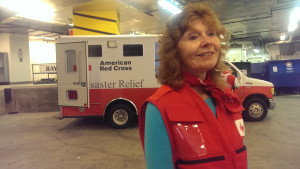Written by Glen and Julie Bradley, IT/Telecommunications volunteers with the American Red Cross Emergency Relief Unit in Nepal, who were deployed immediately following the earthquake to restore critical communications in the region.
 The aftershocks, which have been rolling across Kathmandu sporadically since April 25, shake the region almost as much as the initial 7.8 quake. People are skittish of enclosed spaces. Families whose homes are still standing continue to sleep in the open. Aid workers sleep jumpily in the few so-called ‘earthquake proof’ hotels – a claim that basically gives you time to run from the building before it collapses. Those of us who brought tents vie for the best empty space—the grassy grounds of a nearby hotel closed since the quake. Space is tight as International Federation of Red Cross and Red Crescent Societies (IFRC) relief units from all over the world pour into the Kathmandu airport and then push out toward the epicenter to do help among the growing need and casualties.
The aftershocks, which have been rolling across Kathmandu sporadically since April 25, shake the region almost as much as the initial 7.8 quake. People are skittish of enclosed spaces. Families whose homes are still standing continue to sleep in the open. Aid workers sleep jumpily in the few so-called ‘earthquake proof’ hotels – a claim that basically gives you time to run from the building before it collapses. Those of us who brought tents vie for the best empty space—the grassy grounds of a nearby hotel closed since the quake. Space is tight as International Federation of Red Cross and Red Crescent Societies (IFRC) relief units from all over the world pour into the Kathmandu airport and then push out toward the epicenter to do help among the growing need and casualties.
Laying the Telecommunications Groundwork
As a strange comfort, I keep my portable VHF radio close as I work, monitoring the Red Cross disaster communications network we installed a little over a year ago as part of a joint Earthquake Preparedness Program with the Danish Red Cross. Glen and I, American Red Cross IT/Telecom Emergency Response Unit (ERU) members, previously spent a month in Kathmandu and the foothills of the Himalayas installing a robust radio communications network that covers the entire Kathmandu Valley. Funded by the Danish Red Cross and assisted by the Nepalese Red Cross, we dubbed ourselves the ‘Kathman-duo’ and spent that December working with our Nepalese counterparts installing radio repeaters, antennas, solar panels and battery banks on two mountain tops surrounding Kathmandu. All followed by training sessions with the Nepalese Red Cross staff and volunteers – allowing daily operational use of the network to widely dispersed districts and chapters. That month, we worked long days and weeks with our Nepalese counterparts; forging friendships which opened our eyes to their culture and people.
When Glen and I got the call to deploy to the Nepal earthquake, our thoughts were of our friends – they had not responded to our emails. Were they safe? Had our disaster preparedness communication network survived?
Back to Nepal for Telecommunications Support
We sent an email with our airport arrival time and were relieved to see the smiling faces of our Nepalese friends with arms stretched out to welcome us back. As they loaded our stacks of 70-pound cases of VSATs, computer networking and radio equipment, they told us their survivor stories; where they had been and what they were doing when the quake hit. In our relief to see them safe and well we forgot to ask about our communications network. Then we heard a remote voice and our friend Achyut reached for his radio responding to a call from the Nepal Red Cross headquarters.
The communications network survived. All the planning and hard work paid off; the Danish Red Cross had recognized the need and the American Red Cross worked with the Nepalese Red Cross to make it happen.
Now Glen and I are here in Nepal working the earthquake disaster the only way we know how; supporting the dozens of IFRC disaster response units on the ground with satellite communications, networking and radio capability. It’s a big job, but once again we are working as a combined team – this time with our New Zealand and Nepal Red Cross counterparts.
That capacity building project worked – but now we have a bigger challenge. Do whatever it takes to provide communications to the ever-growing numbers of Red Cross relief and medical teams working across a wide swath of Nepal. The job here is overwhelming, but we will have a lot of help from our friends.
To help those affected by the Nepal Earthquake:
- GIVE: To help those affected by the Nepal Earthquake, visit Redcross.org or contact your local chapter.
- MAP: To help with critical mapping efforts, visit http://tasks.hotosm.org. No experience is needed, just a computer and internet connection.
- SHARE: Spread the word on relief efforts and ways to help online. Find and share information on social channels, including the global Red Cross Twitter account and American Red Cross Facebook and Twitter posts.
